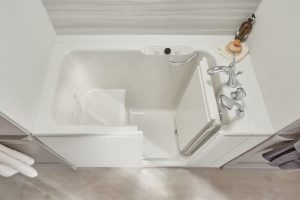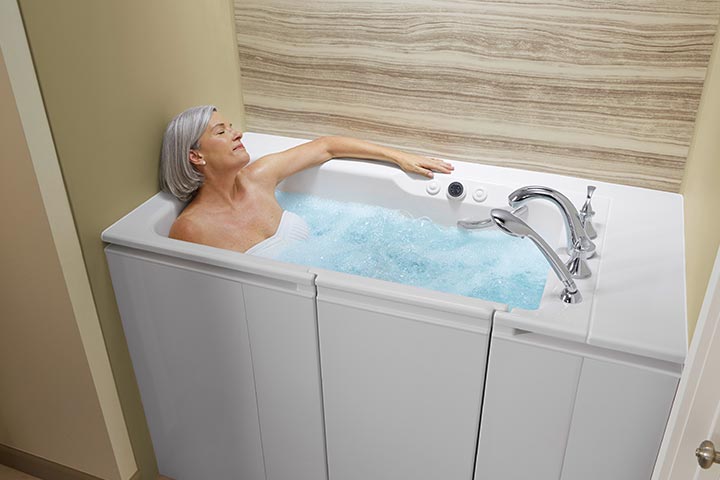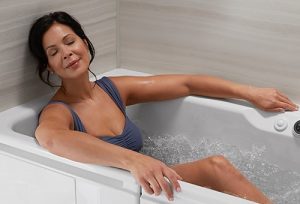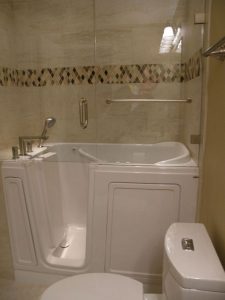Walk In Bath
It is not unusual for clients looking for a bathroom remodel in Irvine, Mission Viejo, Lake Forest, Foothill Ranch, Rancho Santa Margareta, and Aliso Viejo to ask about walk-in tubs. What is a walk in bath? A walk in bath is a bathtub with a watertight door that allows the bather to step into the tub over a low threshold. After the door is closed, the tub fills with water and the bather enjoys a seated, comfortable, safe bathing experience. After the bath, the tub is drained, and the bather opens the door and safely steps out. There are lots of options with a walk in bath.
If you or a loved one has difficulty entering or exiting the tub or shower, you might be considering a replacement walk in bath. A walk in bath is a terrific option for seniors and those with limited mobility. Walk-in baths give any bathroom modern flair while restoring personal independence. These tubs provide easy-access bathing and comfort for all. Purchasing a walk-in bath is a big decision. There are mixed reviews and it can be hard to know which one is right for you. To help answer these questions, I’ve put together information to help you in planning and decision making.
Price of a Walk In Bath:
First, you’ll need to decide what you really want from your walk in bath – affordability, warranty, sooth muscles, improve circulation, relaxation – all of these? Second, the cost to install. This can vary greatly depending on the location of your tub, changes to plumbing, electrical connections, and any adjustments to the layout of the bathroom to accommodate your tub. Generally speaking, expect to pay in the range $1,500 to $3,000 to install a basic walk-in tub.
TIP: I’ve had several clients tell me that some companies they spoke with provided them with an artificially low price that did not include things like demolition, removal of the old tub, disposal of the  old tub, or permits. It was not until the time came to sign the contract, they found this out by reading the fine print! Needless to say, they showed them the front door! At DAD’s Construction, you get a price to do everything. We never pull stunts like this.
old tub, or permits. It was not until the time came to sign the contract, they found this out by reading the fine print! Needless to say, they showed them the front door! At DAD’s Construction, you get a price to do everything. We never pull stunts like this.
TIP: Watch out if the person selling you the job starts pushing financing. A walk in bath is an investment – but you might have few alternatives to maintain an independent lifestyle. This is a clever trap that unfortunately, gets a lot of people. Although that monthly payment or “12 months same as cash” payment makes it look affordable, reality is many of these carry finance rates and hidden charges that meet and exceed credit card rates!
Financing for a Walk In Bath
Recently, I had a finance company reach out to me. They wanted to partner with DAD’s Construction in providing financing alternatives to my customers. One of their many “affordability tactics” was to hide the various fees in the price of the job, then applying finance charges. This effectively made for an interest rate of about 45%! After a few colorful words, I sent him packing! I don’t deal with people who lie, cheat, and steal. A big part of my job is making sure you get great value, high quality, and a lasting job. I won’t disappoint you! I’m your biggest advocate for success!
The below chart gives you an idea of walk-in tub costs.
| Walk in Bath Types | Price Range | Advantages |
| Walk in soaking baths | $1,500-$5,000 | Safety and affordability |
| Hydrotherapy walk in baths | $5,000-$7,000 | Soothes muscles, very relaxing |
| Walk in baths with air baths | $5,000-$9,000 | Improves circulation, very relaxing |
| Combination air and water jet walk in baths | $7,000-$10,000 | Soothes muscles, improves circulation, incredibly relaxing |
| Bariatric walk in baths | $5,000-$10,000 | Handicap accessibility and comfort |
| Walk in baths plus shower unit | $2,500-$6,000 | Combines safety, relaxation, and showering with affordability |
| Luxury walk in baths | $9,000-$20,000 | Lots of features and accessories for an amazing bathing experience combining safety, soothe muscles, reduce pain, and pampering relaxation |
Medicare doesn’t consider walk-in bathtubs to be durable medical equipment (DME – items like hospital beds, wheelchairs, catheters, blood glucose monitors or nebulizers; and a walk in bath can be used by anybody) and will not cover the cost of the tub or installation except in a few extreme cases, such as accommodating somebody with a spinal cord injury. Some Medicaid plans provide reimbursement, but you’ll need to file a claim with details about why the walk-in bathtub is medically necessary.
Are Walk In Baths Tax Deductible?
Walk-in tubs are only tax deductible if they are purchased because of medical safety reasons. If they are purchased because of medical safety reasons, you may be able to claim it as a Medical Expense. If you are the caregiver of an elderly person and install a walk-in tub, you may be able to claim the tub’s cost under the Dependent Care Tax Credit.
Walk-in tubs are an investment. However, for many clients the cost is well worth it, especially If you live in a retirement community. Typically, a walk-in tub increases the value of your home in a retirement community. There’s also the security and health benefits of reduced medical costs associated with typical tub and/or shower slip and fall injuries. Slipping and falling in the bathroom is a dangerous hazard and a common source of injury among seniors. One of the most popular reasons for purchasing a walk-in-tub is the added safety they offer with their handrails, built-in seating, and textured flooring.
Reasons for A Walk in Bath:
 A curb-less entrance reduces risk of injury. The seating allows you to submerge yourself without bending down to the floor and handrails help you steady yourself when you sit and stand.
A curb-less entrance reduces risk of injury. The seating allows you to submerge yourself without bending down to the floor and handrails help you steady yourself when you sit and stand.- For those looking for a home where they can age in place, safety is a top consideration. More specifically, preventing falls. About 46% of falls occur in the home. Over 33% of adults over age 65 fall each year and over 80 percent of those falls are in the bathroom. Close to 32% of these falls result in hospital admission. Walk in baths generally provide an array of features designed to help reduce falls. These often include built-in handrails, ADA compliant overall design, anti-slip flooring, contoured built-in seating, and a low step height for entry.
Do walk in baths ease pain?
- Soaking in warm water can be a great way to relax and reduce muscle pain and tension. It’s also beneficial for those with arthritis. These benefits make walk in baths attractive to many. Walk in baths allow you to fully submerge yourself in warm water safely, helping reduce back pain and other aches.
- Unlike outdoor hot tubs, walk in baths can be used anytime for fast pain relief.
- Because there is no need to step over a tall wall, walk-in tubs provide a deeper water depth when compared to traditional tubs. A standard bathtub has a depth of 13 to 14 inches, while walk-in tubs can provide up to nearly four feet of water depth for a comfortable immersion experience while seated securely.
- Seats are generally placed at 17 inches high, leaving almost 20 inches of depth to immerse the torso, well within the average torso length of an adult. Many walk-in tub models also have hydrotherapy jets available and other luxury features such as chromotherapy lighting and heated seating.
- The benefits of warm water for seniors in reducing certain aches and pains, along with speeding the healing of certain injuries such as burn’s or ulcers is well known. Hydrotherapy can also help patients recovering from amputations or dealing with conditions such as arthritis. In addition to simply being able to soak in deeper warm water, many step-in tubs have hydrotherapy jets similar to what you would find in an outdoor hot tub. Several jets of heated water and air agitate the water and provide massage to relax muscles further.
- Some models include wide doors designed to allow those in wheelchairs to transfer easily to the tub seat without assistance. Another safety feature, although not related to falls, is a scald prevention valve, designed to prevent hot water burns.
Things to Think About When Selecting A Walk in Bath:
- Walk-in tubs can be constricting when a person needs complete bathing assistance. If you have a medical emergency, such as chest pain, you must wait for the tub to drain before you can exit and dial 911 (a waterproof medical device eliminates this risk).
- Some walk in baths fill and drain slowly, meaning you have to sit there and wait, which can lead to discomfort. Walk-ins that operate quickly and come with heated seating can significantly mitigate this problem.
 Walk in baths can cost a lot, and some companies are less than forthcoming about their expense. For many customers, though, the cost is well worth it.
Walk in baths can cost a lot, and some companies are less than forthcoming about their expense. For many customers, though, the cost is well worth it.- Installation costs might be high, depending on your bathroom layout.
- If your water heater can’t support a walk in bath, you might have to purchase a new one. Another excellent option is installing a tankless water heater.
- Quick fill/drain features sometimes require additional bathroom remodeling along with the installation.
- Some installers don’t include hidden costs for things like water jets, heated seats, fast draining/filling fixtures, hand bars, electrical, permits, etc.
- Some tubs can take as long as 15 minutes to fill or drain, although some high-end models have features to speed up this process. Even with rapid fill and rapid drain features, walk-in tubs can average around eight minutes to fill or drain, leaving a significant amount of time where much of the body is exposed to air and can become chilled. One possible way to reduce chilling is to purchase a model with a heated seat.
Water Usage and a Walk In Bath:
Comparable Water Usage. With the deeper size of walk in baths, there is understandably the idea that a walk in bath holds more water than a standard tub or a shower. However, this is not always the case. Many walk in baths are much narrower than standard tubs, so they don’t use as much water as you think. Consider the following:
| Standard Tubs/Showers vs. Walk in Baths | ||
| Standard Tub | Standard Shower | Walk in Bath |
| 42-80 gallons | 25-40 gallons | 50 gallons |
An average standard bathtub holds around 42 gallons, with large soaking tubs holding almost twice as much. An average shower uses between 25 and 40 gallons (depending on the flow of your shower head). Walk in baths do not use significantly more water, with many averaging around 50 gallons of water per filled tub. Many walk-in tubs also offer heating systems that circulate water to keep it warm rather than needing to be refilled during the bath.
Walk In Bath Flooding:
 Most walk in baths have swing-in doors. In other words, the doors swing into the tub for entry. However, some have swing-out doors for easier access. These swing-out doors can make the tub easier to enter. Unfortunately, it also brings the possibility of flooding should the door not be latched properly. If the swing-out door is not secured properly, the weight of the water in the tub could cause the door to open, spilling gallons and gallons of water into your home. Note to the wise – make sure your walk-in tub has a swing-in door, not a swing-out door.
Most walk in baths have swing-in doors. In other words, the doors swing into the tub for entry. However, some have swing-out doors for easier access. These swing-out doors can make the tub easier to enter. Unfortunately, it also brings the possibility of flooding should the door not be latched properly. If the swing-out door is not secured properly, the weight of the water in the tub could cause the door to open, spilling gallons and gallons of water into your home. Note to the wise – make sure your walk-in tub has a swing-in door, not a swing-out door.
Walk in bath doors are water sealed; however, there is always the chance of a seal failure. When a seal becomes worn or fails, water could leak-out onto the floor causing minor to significant flooding. This is not a common occurrence with higher quality tubs. Walk in baths on the lower end of the price spectrum can have issues. Therefore, as with everything, quality matters.
As you can see, walk in baths might not be for everyone, but for those looking for a secure, limited mobility, or handicap-accessible tub, a walk-in tub can offer the perfect solution. These tubs have lots of accessories and features.
Who Makes the Best Walk in Bath?
My preference is Safe Step and Kohler. Both offer a lifetime warranty (which includes the door seal), lots of options, and lots of satisfied customers. Both make their tubs proudly in the USA.
Always Hire a Reliable and Dependable Contractor to Remodel your Bathroom
 Always work with a trustworthy contractor like DAD’s Construction. We are experts in bathroom remodeling who can manage projects in an efficient manner. DAD’s Construction will do everything to minimize the possibility of change orders. Our team will make sure we have all the necessary information to prepare a proposal that meets your requirements. Rest assured that we will provide you with a detailed, by line-item contract. We will make sure that the contents of this agreement are properly and clearly communicated to you. If you have questions or need updates regarding your project, we will always answer your inquiries.
Always work with a trustworthy contractor like DAD’s Construction. We are experts in bathroom remodeling who can manage projects in an efficient manner. DAD’s Construction will do everything to minimize the possibility of change orders. Our team will make sure we have all the necessary information to prepare a proposal that meets your requirements. Rest assured that we will provide you with a detailed, by line-item contract. We will make sure that the contents of this agreement are properly and clearly communicated to you. If you have questions or need updates regarding your project, we will always answer your inquiries.


 Walk in baths can cost a lot, and some companies are less than forthcoming about their expense. For many customers, though, the cost is well worth it.
Walk in baths can cost a lot, and some companies are less than forthcoming about their expense. For many customers, though, the cost is well worth it.